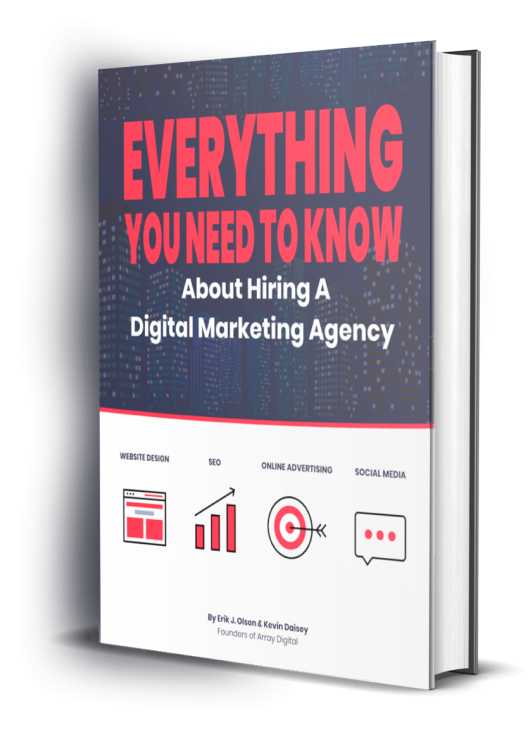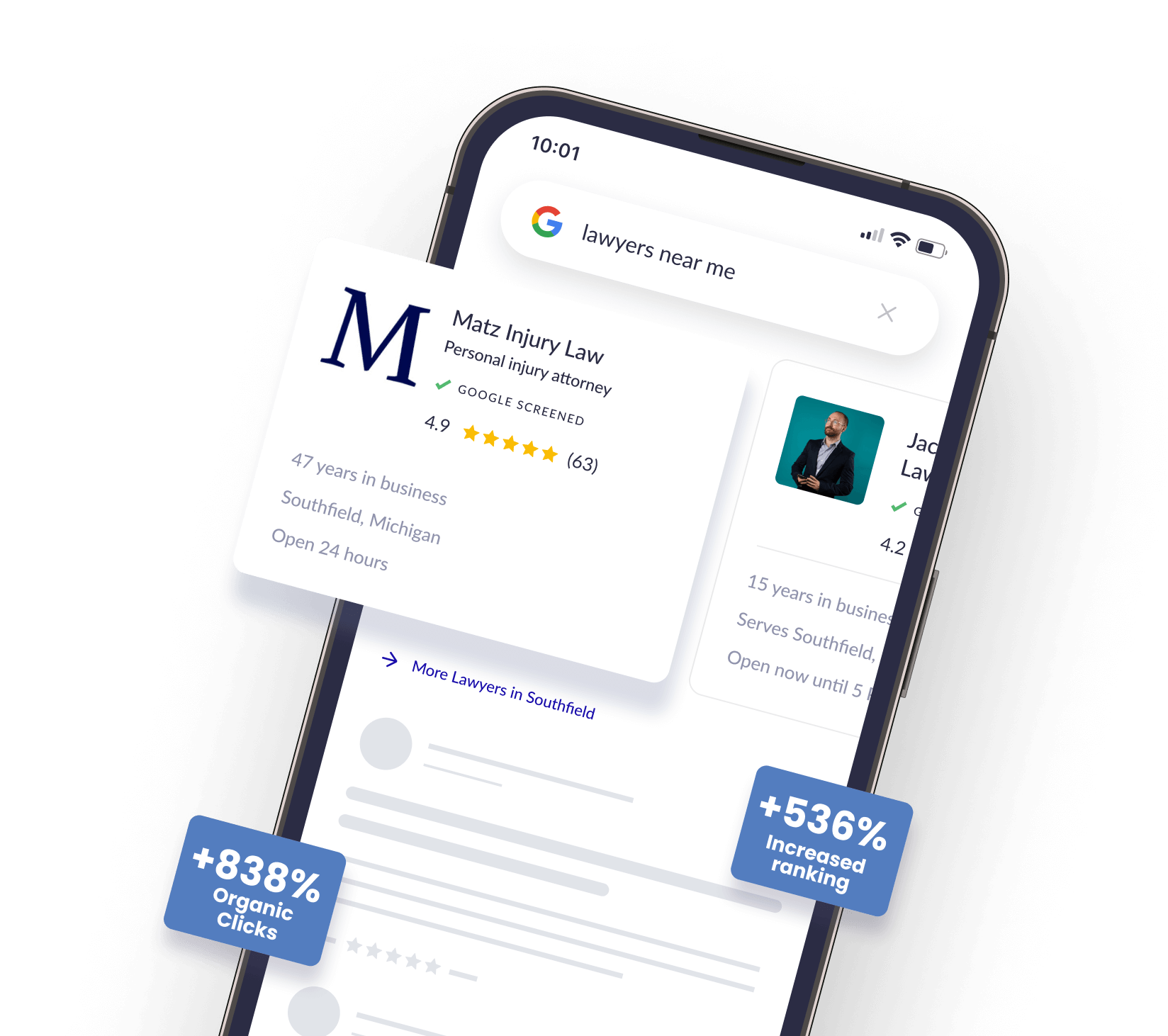Blog
Scaling Your Law Firm’s Budget for Annual Growth

Key takeaways:
- The Profit First Method is an effective, proven way to create permanent profit.
- Reorganizing how you manage business cash flow can drive profitability for your firm.
- Law firm marketing, done well, is a core contributor to efficiency, branding, and profit increases.
- You do not have to put in more hours to become a more profitable, larger, or more successful firm.
I recently did a podcast on the book Profit First. It’s a model of building a profitable business (including a law firm) that can work with almost any business. We have been using it here at Array Digital for over five years. If you want to increase your profitability as a law firm, you have come to the right place. Today, we’re going to talk about how law firms can increase their revenue through strategies, insights, and results-driven data with a proven track record of increasing law firm profitability.
About the Profit First Book
Profit First by Mike Michalowicz is an innovative way of thinking about profit. The premise is that it’s possible (and necessary in today’s world) to transform how you pay yourself a profit to make your company permanently profitable.
Why are businesses across the U.S. taking on such a drastically different way of approaching profit? It’s simple. If your law firm is operating check-to-check or just meeting some basic objectives, you could be facing significant stress. A lack of cash reserves may be holding you back from reaching profit goals and increasing your company’s overall growth.
The author shares that there are over 175,000 companies throughout the country using this system. As I mentioned, Array Digital is one of them. It’s a simple premise with a profound impact. I can tell you that honestly because it’s what’s helped our business. So, what is it? Profit First is a method for organizing your cash flow.
A breakdown of the Profit First Method
In the Profit First Method, your cash — all of the money coming into your law firm — goes into a single account called your “income.” You then disburse into other accounts based on specific goals. From there, you divide your bank account and allocate funds based on percentages. Here’s how that happens:
- Income: This account receives all of the money coming into your business. You will then fund other accounts or divisions in your account from the funds here.
- Profit: The first priority is to put a percentage of money into your profit — this is first, not based on what’s left over.
- Owners compensation: This category is what you pay yourself — it’s what you are earning or your salary for doing the job you do. This is not profit but guaranteed compensation paid to you for providing the services you do. Profit and owner compensation are two separate elements.
- Operating expenses (OPEX): Operating expenses are a catch-all. It’s the account you use to pay your bills, and as a result, it tends to have a substantial amount of money in it.
- Taxes: The business taxes you must pay should come from the business, not the profit or your income. It should sit in this account until it is time to pay them.
- Other accounts: You can have other accounts for other purposes and goals.

Organizing your disbursements with Profit First
Now that you have this structure in place, the Profit First Method provides a method for disbursing money into an account. Remember that all the money coming into your business goes into your income account. You then disburse all money from this account to other accounts you’ve created based on a percentage. According to the Profit First Method, disbursements occur on the 10th and 25th of the month.
Let’s do an example breakdown of bank accounts and their respective percentages so you can get a better idea of how to allocate your cash flow.
- Profit account: allocate 6%
- Guaranteed payment (owners pay): 10%
- Owner’s tax: 3.5%
- Payroll: 20.4%
- License and insurance: 0.5%
- Petty cash: 2%
- OPEX: 59.2%
It is critical to allocate funds and create a basis for all profit. This is not something to set up and do after the month is over. You should have the plan and structure in place heading into your business.
Diving into the key metrics of law firm profitability
Now that you have a sound structure for managing and controlling overhead costs with the Profit First Method, it’s time to consider other factors that contribute to the overall profitability of law firms. Specifically, consider how you need to track profitability.
Cash flow
Cash flow is the sustainable, positive flow of money coming into the business and out of it.
- Used to pay bills and meet growth objectives
- Challenging if not paid immediately (common with personal injury attorneys, among others)
Tracking your cash flow helps pinpoint inefficiencies that lead to losses. A cash flow metric can also help you make financial projections.
Utilization rate
The utilization rate is the law firm’s billing efficiency and overall productivity. It measures the number of hours worked compared to the hours paid.
- Aids attorneys in minimizing non-billable investments of their time
- Pinpoints specific inefficiencies in your daily operations, including all aspects of case management
Some forms of practice management software can help monitor the utilization rate. Look for ways to trim back inefficiency to increase profitability.
Realization rate
The realization rate is the number of billable hours your law firm has accrued versus the amount you’ve been involved in successfully.
- A low realization rate could indicate a lack of efficient payment methods or a pricing strategy out of line with expectations.
- Tracking it can help uncover cash flow patterns that could indicate a problem within your law firm’s pricing, client selection, or other areas.
- Use timekeepers and other strategies for a deeper understanding of what your hours of work are achieving.
Billable hours
Billable hours, or billable time, are the hours you can charge your clients a fee compared to non-billable hours necessary to run your business.
- You will have non-billable hours in a law practice because there is non-billable work you have to do.
- When possible, aim to delegate those tasks (particularly administrative tasks) to others, such as paralegals or support staff, to minimize the time you are not working on billable hours.
- Consider the opportunity to automate some tasks to increase profit margin.
- Use time tracking or a time management system to know where you stand.
- Ensure your hourly rates reflect the local competitive industry, not just what you believe your billable work should be.
Outstanding A/R balances
Having a high outstanding accounts receivable balance isn’t uncommon with attorneys, but it does impact your cash flow. You must have a strategy for managing accounts receivable, especially from non-paying clients.
- Client satisfaction can impact your A/R balance, as unsatisfied customers are less likely to pay promptly.
- Consider client intake, client relationship concerns, and support staff factors that could impact why clients are not making payments.
- Identify the cause for these high balances to improve cash flow throughout your law office.
- Put in place an effective collection process to maintain firm revenue.
- Consider implementing digital payment methods that increase client convenience.
Ten impactful methods for increasing law firm profitability (every year)
While these ten methods are valuable, the key to building profit within a law firm extends beyond these strategies. You must remain relevant and consistently market your business to develop new leads and growth. Lawyers typically cannot simply rely on their current reputation, referrals, or existing clients. Consider these strategies.
Branding and web design

Legal professionals who want people in need of legal services to find them must have a beautiful website and an established brand.
- A well-designed, easy-to-navigate website helps would-be clients to find your law firm where they are looking for it — online.
- Web design helps support search engine optimization (SEO), allowing your website to be found easily by prospective clients.
- Branding allows people to get to know you, your firm, and what makes you different so they can continue to remember you.
Making informed decisions with SEO
SEO is the foundation of your legal marketing. It allows Google to rank you on the search engine results pages (SERPs) when people seek out a service you offer, such as a practice area you serve within your local area.
- SEO helps you to get new clients on a consistent, long-term basis.
- SEO offers the best return on investment (ROI) because it is an investment that continues to pay off.
- Done well, SEO can offer higher profitability in all forms of legal marketing since it creates ongoing results to achieve targeted leads.
Targeted content marketing
Content marketing is the process of building content that supports your SEO strategies and provides valuable information to prospective clients.
- Use content as a way to generate leads for your legal practice.
- Build your brand with high-quality content.
- Become a thought leader within your legal industry sector to drive more engagement.
Deep dive competitor analysis
You cannot know how well your legal work pricing is or how well you are competing without understanding your competitors.
- Learn where your competitors’ weaknesses lie so you can streamline your marketing to target those areas.
- Determine which billing processes your competitors use that could make them a more attractive option (like a flat fee instead of hourly or a no-pay promise if they do not win).
- Alter your own brand strategy to compete.
Social media marketing
Help people make decisions by being present where they are — on social media. Social media marketing typically includes Facebook, LinkedIn, Instagram, and other platforms where your prospective clients may be.
- Use social media marketing to build your brand.
- Use social media to engage with your current and prospective clients, often driving up retention because of their personable experience with your firm.
- Disseminate your content on social media to reach new clients and bring them to your website.
Email marketing
Email marketing allows you to continue to engage with your existing clients or those who have reached out.
- Pull in new leads from referrals through email marketing.
- Use legal technology to track open rates for emails to determine what type of content people want to read from you.
- Use email as a way to remain fresh in the minds of clients who have worked with you in the past for solid retention.
Google Business Profile reviews and ratings

Your Google Business Profile helps you reach targeted leads who are googling to find an attorney within their local area who can meet their needs.
- Your Google Business Profile provides an instant way for people to connect with you, allowing them to call you right from the search engine result page.
- Reviews help give would-be clients confidence in your firm based on past client experiences.
- Your profile establishes and communicates your brand, building on the ways people can find you.
Podcasting and video making
Podcasting and video making can help people get to know who you are, what your brand stands for, and how well you can meet their needs.
- It allows prospective clients to learn about your legal philosophy.
- Podcasts and videos connect with people who may need answers and prefer audio or video form.
- These are long-term investments, too, continuing to generate leads over time.
Referrals and business cards are still relevant
It’s still viable to hand out your business card and ask your clients for referrals. Integration of technology with traditional networking helps to drive profitability.
- Encourage people to refer you to help support your effort (it costs nothing to reach these clients).
- Use business cards as a way to build a local network.
Chamber of Commerce and community involvement
In order to drive profitability and improve your bottom line, you have to be present in as many ways as possible, including locally.
- Being a member of the Chamber of Commerce allows for local recognition as well as referrals.
- Being involved in the community not only builds your brand but also creates opportunities to boost SEO (such as getting your law firm’s name in the paper).
Why law firms partner with Array Digital

All of the factors we use to help our clients see success, the key performance indicators (KPIs) we encourage, along with other analyses and metrics, come down to one goal: help drive profitability for your business. We care about our clients’ ambitions to help people and build their reputation, but also their bottom line.
Our experience and expertise in law firm marketing help drive profitability metrics for our clients. We listen to you and then create a custom strategy for your law firm.
Testimonials
Don’t just take our word for it. Hear what our clients have to say about our services.
James K.: “Array Digital has built an awesome website for our law firm and has used SEO to move us to the top [of] the page on Google. Two of our best recent settlements were for clients who found us on Google, which is a direct result of the great work Array [Digital] has done for us. They are true professionals who know their stuff!”
Sergio V.: “Have worked with Array for several years, and after having website management / SEO services provided by many companies over the years, Array has been the most productive and effective for my business. They have always remained professional and stay on top of such an ever-changing industry. Their customer service is superb!”
Greg T.: “Kevin and the Array Digital team are exceptional at what they do! If you are looking to grow your law firm, look no further. Array is the expert team that you need to take the complexities of digital marketing off of your plate and bring customers that need you to your doorstep.”
Frequently asked questions about increasing law firm profitability
Which portion of my Profit First budget should go towards marketing?
Your marketing budget is similar to your payroll expense. Typically, law firms with one million in revenue should be spending at least $5,000 a month on marketing. This is, then, your cheapest “employee” on the payroll. With Array Digital, that one employee is actually a full team of professionals working for your profitability.
What are the most profitable law firm practices?
We mentioned some above, but others to consider:
- Structure your budget with methods like Profit First.
- Manage your billable hours with technology so you can use detailed profitability analysis to make data-driven decisions.
- Invest in marketing.
- Network with your local community.
What are the main things small law firms misinterpret about finances?
Consider these common misinterpretations of law firm finances:
- It’s not just about working more hours to increase profitability.
- You have to target the ideal target client, one who will pay on time and well for quality service.
- You need to sell with your competitors in mind — what can you do that they are not?
What is the average profit margin for law firms?
Various factors impact the average profit margin for law firms, but:
- Average law firms have a profit margin of about 25%.
- Leading law firms typically have a profit margin of around 35%.
- The largest, most efficient firms can reach 70%.
Drive your law firm’s profitability for yearly growth with Array Digital
Do not cut your marketing budget this year. Instead, let Array Digital fine-tune your strategy with profit and your bottom line in mind. It’s not about spending more but making better decisions. Spend one of those non-billable hours building profit by calling Array Digital at 757-333-3021 or contact us online now.

Everything you need to know about hiring a digital marketing agency:
- The four pillars of digital marketing
- Digital marketing options and costs
- The pitfalls to avoid
- What to expect when working with an agency
- The qualities to look for in a digital marketing agency

Related Entrepreneurship Articles
Extraordinary Results
-
“Erik and the Array Digital team are top notch in the digital marketing spaces, particularly for SEO. Their understanding of Google, the algorithms, and the work involved to get websites ranking on the first page is unparalleled. Thank you Erik!!”
Andrew ZihmerZihmer Law Firm -
“I had a chance to consult with Kevin Daisey for my law firm’s marketing needs. He is knowledgeable, kind, and helpful. He provided me with a great marketing analysis. He also invited me to their podcast as a guest speaker. Thank you Array Digital!”
Merve KatiZMK Law -
“The legal profession needs more architects and designers…folks who are thinking about the future of the profession and who are assembling a tribe of like minded lawyer leaders. Erik and his team are certainly ‘that’.”
Ben GlassBen Glass Law & Great Legal Marketing







